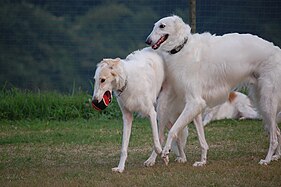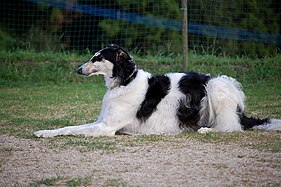| Borzoi | |||||||||||||||||||||||||||
|---|---|---|---|---|---|---|---|---|---|---|---|---|---|---|---|---|---|---|---|---|---|---|---|---|---|---|---|
 | |||||||||||||||||||||||||||
| Other names |
| ||||||||||||||||||||||||||
| Origin | Russia | ||||||||||||||||||||||||||
| |||||||||||||||||||||||||||
| |||||||||||||||||||||||||||
| Dog ( domestic dog ) | |||||||||||||||||||||||||||
The Borzoi [a] or Russian Hunting Sighthound [b] is a Russian breed of hunting dog of sighthound type. It was formerly used for wolf hunting, [2] : 125 and until 1936 was known as the Russian Wolfhound. [2] : 130 [3]











